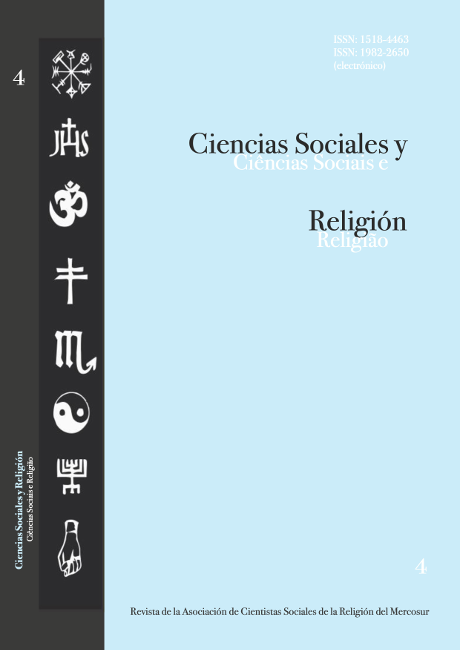Abstract
In the early 1980’s, several Wichí aborigine groups of Argentinaadopted a Pentecostal-like religion known as “Evangelism” or “EvangelicMovement” that 40 years earlier had taken root among the Toba due tothe arrival of several American Pentecostal churches in the Province ofChaco. As this new religion began to emerge, the Wichí undertook aprocess of identity transformation characterized, as a whole, by a deeprejection of several features of their own culture and a staunch adherenceto the precepts of Christian morality that had already been adopted in thecontext of the missionary project that the Anglican Church had set inmotion at the beginning of the 20th century. Evangelism provided therequired elements for a new presentation of subjects in daily life and asignificant alteration of the political and religious scenario. This not onlyallowed for the elaboration of a new identity towards the group ofbelonging, but also encouraged the efforts to show the enveloping societya model of subject who might avoid the stigma of being an “Indian”.
References
BARTOLOMÉ, Leopoldo J. 1972. “Movimientos milenaristas de los aborígenes chaqueños entre 1905 y 1933”. Suplemento Antropológico 7 (1-2): 107-118.
BARÚA, Guadalupe. 1986. “Principios de organización en la sociedad Mataco”. Suplemento Antropológico 21 (1): 73-129.
BASTIAN, Jean-Pierre. 1997. La mutación religiosa de América Latina. Para una sociología del cambio social en la modernidad periférica. México: Fondo de Cultura Económica.
BRAUNSTEIN, José. 1992-93. “Territorio e historia de los Narradores Matacos». Hacia una nueva carta étnica del Gran Chaco V: 4-74. Centro del hombre antiguo chaqueño.
BRAUNSTEIN, José. 1995. The Space of Language and Society Among the Native Peoples of Argentinian Chaco. Inédito.
BRAUNSTEIN, José. 1997. “El chamanismo y el espacio religioso de la ‘misa’ de los mataco”. In:
Shamanismo sudamericano , Juan Schobinger, comp., 69-86. Buenos Aires: Continente – Almagesto.
BRAUNSTEIN, José & GARCÍA, Miguel A. 1996. “Estabilidad y cambio de la música ritual en el este de la cadena cultural mataca”. Scripta Ethnológica XVIII: 143-155.
CORDEU, Edgado. 1984. “Notas sobre la dinámica sociorreligiosa Toba-Pilagá”. Suplemento Antropológico 29 (1): 187-235.
CORTEN, André. 1995. Le pentecôtisme au Brésil, émotion du pauvre et romantisme théologisque. París: Khartala.GARCÍA, Miguel A. 1998a. “Conversión religiosa y cambio musical”. Latin American Music Review 19 (2): 203-217. Universidad de Texas.
GARCÍA, Miguel A. 1998b. “Mundos imaginarios y experiencias perceptivas. La música ritual de los wichí”. Resonancias 3: 60-74. Instituto de Música de la Universidad Católica de Chile.
GUERRERO JIMÉNEZ, Bernardo Segundo. 1994. A Dios rogando..... Los pentecostales en la sociedad aymara del norte grande de Chile. Amsterdam.
IDOYAGA MOLINA, Anatilde. 1994. “La misionización y el surgimiento de nuevas formas terapéuticas y culturales entre los pilagá (Chaco Central)”. Anthropologica XII (12): 135-157.
IDOYAGA MOLINA, Anatilde. 1996. Entre el mito y la historia. La mitificación de un lider mesiánico. Scripta Ethnologica XVIII: 167-183.
MILLER, Elmer S. 1979. Los tobas argentinos. Armonía y disonancia em una sociedad. México: Siglo Veintiuno Editores.
PIQUERAS INFANTE, Andrés. 1993. “Ritual, tradición y reforzamiento de la identidad comunitaria. El ejemplo de la Pasión de Borriol”. Recerca Revista de Pensamienti Análisi XVII (4): 93-101.
PIQUERAS INFANTE, Andrés. 1996. La identidad valenciana. La dificil construcción de una identidad colectiva. Madrid: Escuela Libre.
PIQUERAS INFANTE, Andrés. 1997. Conciencia, sujetos colectivos y praxis transformadoras en el mundo actual. Madrid: Sodepaz
PIÑA, Joaquín. 1995. “Juntos, para defender los derechos humanos”. In: Bastian, Jean-Pierre et al., Evangélicos en América Latina. Quito: Abya-Yala.
RIVIÈRE, Gilles. 1997. “Bolivie: le pentecôtisme dans la société aymara des hauts-plateaux”. Problémes d’Amérique latine 24:81-102.
SEGATO, Rita. 1993. “Cambio religioso y desetnificación: la expansión evangélica en los Andes centrales de Argentina”. Etnía 38-39: 85-124.
VUOTO, Patricia Marina. 1986. “Los movimientos de Luciano y Pedro Martínez, dos cultos de transición entre los Toba-tasék de Misión Tacaagle”. Scripta Ethnologica 10: 19-46.
VUOTO, Patricia & WRIGHT, Pablo. 1991. “Crónicas del Dios Luciano. Un culto sincrético de los toba y pilagá del Chaco argentino”. In: El mesianismo contemporáneo en América Latina, Alicia M. Barabas coordinadora, 149-180. Religiones Latinoamericanas 2.
WALLERSTEIN, Immanuel. 1991. “La construcción de los pueblos: racismo, nacionalismo, etnicidad”. In: Balibar Etienne & Wallerstein Immanuel, Raza, nación y clase. Madrid: Iepala.

This work is licensed under a Creative Commons Attribution-NonCommercial-ShareAlike 4.0 International License.
Copyright (c) 2020 Miguel García
